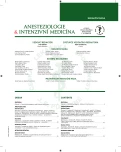-
Medical journals
- Contact
Myasthenia gravis and anaesthesia – a new and safer approach
Authors: Vymazal Tomáš; Horáček Michal; Bicek Vladimír; Filaun Martin
Authors‘ workplace: Klinika anesteziologie, resuscitace a intenzivní medicíny 2. lékařské fakulty Univerzity Karlovyve Fakultní nemocnici v Motole, Praha
Published in: Anest. intenziv. Med., 25, 2014, č. 1, s. 21-24
Category: Anesthesiology - Review Article
Overview
Myasthenia gravis impairs neuromuscular transmission. Its therapy is pharmacological, immunological and surgical by thymectomy. Surgery, anaesthesia and other factors can induce exacerbation of myasthenia. The safest technique of anaesthesia has not been determined. Anaesthesia without muscle relaxation recommended, either deep inhalational anaesthesia, or propofol with opioids, or regional anaesthesia. If neuromuscular blocking agents are needed to create a motionless surgical field, the main problem is neuromuscular transmission impairment. Myasthenic patients react on these agents unpredictably. The most feared complication is a prolonged effect preventing spontaneous ventilation with an increased risk of aspiration and a decreased reaction to hypoxia. In these circumstances mechanical ventilation can be continued. Pharmacological reversal can be attempted but it can induce a cholinergic crisis and its effect is usually limited. A new possibility is the use of rocuronium for muscle relaxation with reversal by sugammadex. Rocuronium and sugammadex could offer a new, effective and safe approach to general anaesthesia in myasthenic patients.
Keywords:
general anaesthesia – myasthenia gravis – neuromuscular junction – rocuronium – sugammadex
Sources
1. McGrogan, A., Sneddon, S., de Vries, C. S. The incidence of myasthenia gravis: a systematic literature review. Neuroepidemiology, 2010, 34, p. 171–183.
2. Špalek, P. Myastenia gravis. Cesk. Slov. Neurol. N., 2008, 104, 71, p. 7–24.
3. Jani-Acsadi, A., Lisak, R. P. Myasthenia Gravis. Current Treatment Options in Neurology, 2010, 12, p. 231–243.
4. Gritti, P., Sgarzi, M., Carrara, B., Laterna, L. A., Novellino, L., Spinelli, L. et al. A standardized protocol for the perioperative management of myasthenia gravis patients. Experience with 110 patients. Acta Anaesthesiol. Scand., 2012, 56, p. 66–75.
5. Černý, V., Adamus, M., Cvachovec, K., Ševčík, P., Herold, I. Anestezie v České republice 2010 – jednodenní prospektivní observační dotazníková studie. Anest. intenziv. Med., 2011, 22, p. 5–12.
6. Rudzka-Nowak, A., Piechota, M. Anaesthetic management of a patient with myasthenia gravis for abdominal surgery using sugammadex. Arch. Med. Sci., 2011, 7, p. 361–364.
7. Souhrn údajů o přípravku BRIDION 100 mg/ml injekční roztok (revize textu 27.2.2012).
8. Sungur, Ulke Z., Yavru, A., Camci, E., Ozkan, B., Toker, A., Senturk, M. Rocuronium and sugammadex in patients with myasthenia gravis undergoing thymectomy. Acta Anaesthesiol. Scand., 2013, publikováno elektronicky předem (doi: 10.1111/aas.12123).
9. Kiss, G., Lacour, A., d’Hollander, A. Fade of train-of-four ratio despite administration of more than 12 mg kg-1 sugammadex in a myasthenia gravis patient receiving rocuronium. Br. J. Anaesth., 2013, 110, p. 854–855.
10. Nakamori, E., Nitahara, K., Sugi, Y., Katori, K., Matsu-zaki, A., Higa, K. Reversal of rocuronium induced neuromuscular block with sugammadex in a patient with myasthenia gravis. Masui., 2013, 62, p. 972–974.
Labels
Anaesthesiology, Resuscitation and Inten Intensive Care Medicine
Article was published inAnaesthesiology and Intensive Care Medicine

2014 Issue 1-
All articles in this issue
- Comparison of opioid and non-opioid analgesia after caesarean section under general anaesthesia: a prospective observational study
- Clash of concurrent urgent and acute caesareansections – case report
- Myasthenia gravis and anaesthesia – a new and safer approach
- Focused on pre-renal acute kidney injury – has the time come to rewrite the textbooks?
-
Current Practice in Obstetric Anaesthesia.
Part III. Regional anaesthesia for caesarean section -
Karl Koller – the discoverer of the local anaestheticproperties of cocain, was born in Susice!
A short history of local anaesthetics
- Anaesthesiology and Intensive Care Medicine
- Journal archive
- Current issue
- Online only
- About the journal
Most read in this issue- Myasthenia gravis and anaesthesia – a new and safer approach
-
Current Practice in Obstetric Anaesthesia.
Part III. Regional anaesthesia for caesarean section -
Karl Koller – the discoverer of the local anaestheticproperties of cocain, was born in Susice!
A short history of local anaesthetics - Focused on pre-renal acute kidney injury – has the time come to rewrite the textbooks?
Login#ADS_BOTTOM_SCRIPTS#Forgotten passwordEnter the email address that you registered with. We will send you instructions on how to set a new password.
- Contact

